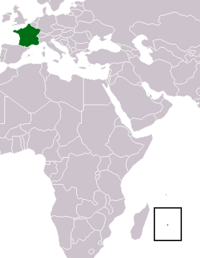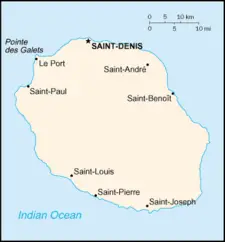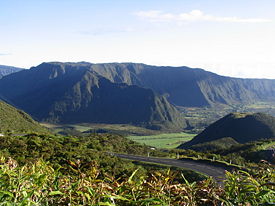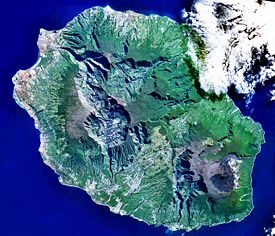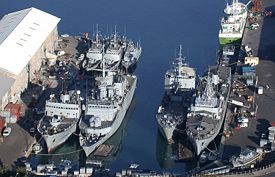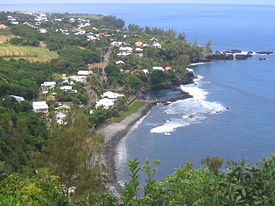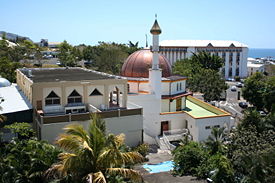Réunion
| Région Réunion | ||
|---|---|---|
| Location | ||
| ||
| Administration | ||
| Capital | Saint-Denis | |
| Regional President | Didier Robert | |
| Departments | Réunion | |
| Arrondissements | 4 | |
| Cantons | 49 | |
| Communes | 24 | |
| Statistics | ||
| Land area1 | 2,512 km² | |
| Population | (Ranked 21st) | |
| - January 1, 2009 est. | 827,000[1] | |
| - March 8, 1999 census | 706,300 | |
| - Density (2006) | 312/km² | |
| 1 French Land Register data, which exclude lakes, ponds, and glaciers larger than 1 km² (0.386 sq. mi. or 247 acres) as well as the estuaries of rivers | ||
Réunion is an island, located in the Indian Ocean east of Madagascar, about 130 miles (200 km) southwest of Mauritius, the nearest island. Administratively, Réunion is one of the overseas départements of France. Like the others, Réunion is also one of the twenty-six regions of France and an integral part of the Republic with the same status as those situated on the European mainland.
It is part of the Mascarene Islands, which are volcanic in origin; Mauritius is the oldest of the existing islands, and was created 8-10 million years ago. Réunion, the largest, was created in the last two million years. The island chain was home to a number of endemic species of both plants and animals, but deforestation and the introduction of non-native species has caused the extinction of many. The collective title is derived from the Portuguese navigator Pedro Mascarenhas, who first visited them in 1512.
Geography
The island is 39 miles (63 km) long; 28 miles (45 km) wide; and covers 970 square miles (2512 sq km). Its area is slightly smaller than the U.S. state of Rhode Island. It is similar to the island of Hawaii insofar as both are located above hotspots in the Earth's crust.
The Piton de la Fournaise, a shield volcano on the eastern end of Réunion Island, rises more than 8,565 feet (2611 m) above sea level and is sometimes called a sister to Hawaiian volcanoes because of the similarity of climate and volcanic nature. It has erupted more than 100 times since 1640 and is under constant monitoring. It most recently erupted on April 4, 2007. The lava flow from this eruption was estimated at about four million cubic yards (3 million m3) per day. The Piton de la Fournaise is created by a hotspot volcano, which also created the Piton des Neiges and the islands of Mauritius and Rodrigues.
The Piton des Neiges volcano, the highest point on the island at 10,069 feet (3070 m) above sea level, is northwest of the Piton de la Fournaise. Collapsed calderas and canyons are southwest of the mountain. Like Mauna Kea on the big island of Hawaii, Piton des Neiges is extinct. Despite its name, snow (French: neige) practically never falls on the summit.
The terrain is mostly rugged and mountainous. The slopes of both volcanoes are heavily forested. Cultivated land and cities like the capital city of Saint-Denis are concentrated on the surrounding coastal lowlands.
Réunion also has three calderas: the Cirque de Salazie, the Cirque de Cilaos, and the Cirque de Mafate. The latter is accessible only by foot or by helicopter.
Natural resources are fish, arable land, and hydropower.
In May 2007, waves reaching up to 11 meters devastated the southern port of Saint Pierre, originating from a storm south of Cape Town, South Africa.
Geology
Of the original seven Mascarene islands to rise out of the Indian Ocean due to the Réunion hotspot, eventually three were completely submerged, and one is a coral atoll. Only three (Mauritius, Reunion, and Rodrigues) remain today. Réunion is home to the highest peaks in the Mascarenes.
The Mascarene Plateau is an undersea plateau that extends approximately 2000 km, from the Seychelles to Réunion. The plateau covers an area of over 115,000 km² of shallow water, with depths ranging from 8 to 150 meters, plunging to 4000 m at its edges. The southern part of the plateau was formed by the Réunion hotspot. Limestone banks found on the plateau are the remnants of coral reefs, indicating that the plateau was a succession of islands. Some of the banks may have been islands as recently as 18,000-6,000 years ago, when sea levels were as much as 130 meters lower during the most recent ice age.
Flora and fauna
The Mascarene islands form a distinct ecoregion, known as the Mascarene forests. The islands were formerly covered in tropical moist broadleaf forest, and harbored a diverse range of forest types. Near the seacoast were coastal wetlands and swamp forests, transitioning to rainforest to windward and lowland dry forest to leeward, palm savannas, montane deciduous forests, and montane heathlands on the highest peaks of Réunion.
The islands are home to many endemic plants and animals, most of which are thought to be derived originally from Madagascar and Africa. The islands were never connected to the mainland, so the flora and fauna of the Mascarenes arrived from over the sea. Prehistoric islands of the Mascarene Plateau, now disappeared under the sea, may have served as "stepping stones" that allowed species to island-hop from the Seychelles or Madagascar.
On all of the Mascarene Islands, there has been a vast loss of the original forest habitat. On Réunion, forest and other habitat was cleared for agriculture and degraded through the introduction of alien plants. Much of the island has been reforested, however, and it now contains almost 40 percent forest cover.
The flora is diverse and contains many unique species. There are approximately 955 species of flowering plants on these islands in 108 different families and 323 genera. Thirty-eight of the plant genera are considered endemic, and there are approximately 695 endemic species. Most of the flora have affinities with Africa and Madagascar; however, a small percentage is more closely related to that of Asia. Of particular interest is the high diversity of palm species, including many endemic genera.
The islands have no native mammals, except for bats. Many of the Mascarene birds evolved into flightless forms, the most famous of which was the Dodo, an extinct flightless pigeon of Mauritius. Sixteen endemic bird species survive on the islands. The bird species confined to Réunion are the Réunion cuckoo-shrike, Réunion stonechat, Réunion olive white-eye, and Réunion bulbul.
Mauritius, Réunion, and Rodrigues were also each home to one or more species of giant tortoise. There are 13 living endemic reptile species, including a number of species of day geckoes.
Many of the native Mascarenes flora and fauna have become endangered or extinct since the human settlement of the islands in the seventeenth century. Settlers cleared most of the forests for agriculture and grazing, and introduced many invasive species, including pigs, rats, cats, monkeys, and mongooses. Fourteen bird species became extinct; the extinct species include the Réunion Flightless Ibis. The giant tortoises are also extinct.
The forests shelter many species of birds and a few mammals such as the tenrec, which resembles a hedgehog. Many species introduced by the explorers and early settlers live today in semi-liberty: hares, rabbits, and Java deer. Many dogs can be found abandoned and wandering about the streets. The chameleon and gecko are common. Offshore, whales come to give birth, and sharks, tropical fish, and octopus abound. Less common are sea turtles.
While a number of birds originally found on Réunion have become extinct, others are endangered or protected, such as the tropicbird, which nests on cliffs; the Réunion harrier, which lives in the forest near the calderas; and the Réunion cuckoo-strike. Barau's petrel lives near the harbors and is never far from the fishermen. The common moorhen usually lives in ponds but can sometimes be seen in the Indian Ocean.
Climate
The climate is tropical and humid but is influenced by the high mountains. During the hot, rainy summer (December to March) average temperature is 81°F (27°C) on the coast but drops to 64°F (18°C) in the mountains. During winter (April to November), average temperature is 72°F (22°C) on the coast and 52°F (11°C) at higher elevations; snow fell in August 2003. The cyclone season is usually between December and February.
The southeast trade winds blow year-round. The east coast is considerably wetter than the dry, brown west coast, but the most rain falls on the mountains above the east coast.
Between March 15 and 16, 1952, Cilaos at the center of Réunion received 73.6 inches (1,869.9 mm) of rainfall. This is the greatest 24-hour precipitation total ever recorded on Earth. The island also holds the record for most rainfall in 72 hours, 154.7 inches (3,929 mm) at Commerson's Crater in March 2007.
History
Arab sailors formerly called the island Adna Al Maghribain (“Western Island”). The Portuguese were the first Europeans to visit, finding it uninhabited in 1513 and naming it Santa Apollonia, after Saint Apollonia.
The island was occupied by France and administered from Port Louis, Mauritius. Although the French flag was hoisted in 1638, Santa Apollonia was officially claimed by Jacques Pronis of France in 1642, when he deported a dozen French mutineers to the island from Madagascar. The convicts were returned to France several years later, and in 1649, the island was named Île Bourbon after the royal house.
“Réunion” was the name given to the island in 1793 with the fall of the House of Bourbon in France; the name commemorates the union of revolutionaries from Marseille with the National Guard in Paris, which took place on August 10, 1792. In 1801, the island was renamed "Île Bonaparte," after Napoleon Bonaparte. The island was taken by the British navy in 1810, which used the old name of “Bourbon.” When it was restored to France by the Congress of Vienna in 1815, the island retained the name of "Bourbon" until 1848, when the fall of the restored Bourbons during the revolutions during that year meant that the island became “Réunion” once again.
From the seventeenth to the nineteenth centuries, French immigration supplemented by influxes of Africans, Chinese, Malays, and Indians gave the island its ethnic mix. The opening of the Suez Canal in 1869 cost the island its importance as a stopover on the East Indies trade route.
Réunion became an overseas department of France on March 19, 1946.
In 2005 and 2006 Réunion was hit by a crippling epidemic of Chikungunya virus, a disease spread by mosquitoes. About 255,000 people on Réunion reportedly contracted the disease, which also spread to Madagascar and to mainland France through airline travel. The disease led to more than 200 deaths on Réunion. Though the epidemic is considered over, some risk remains. There is no known cure.
Politics
Réunion sends five deputies to the French National Assembly and three senators to the French Senate. Chief of state is President Sarkozy, represented by a prefect. Head of government are the president of the General Council and the president of the Regional Council.
The French president is elected by popular vote for a five-year term; the prefect is appointed by the French president on the advice of the French Ministry of the Interior. The presidents of the General and Regional Councils are elected by the members of those councils
The 47 seats of the unicameral General Council are elected by direct popular vote to serve six-year terms. The 45 seats of the unicameral Regional Council are elected by direct popular vote to serve six-year terms.
The legal system is based on French law.
Administrative divisions
Administratively, Réunion is divided into 4 arrondissements, 24 communes, and 47 cantons. It is a French overseas département as well as a French region. The low number of communes, compared to French metropolitan departments of similar size and population, is unique; most Réunionnaises communes encompass several localities, sometimes separated by significant distances.
Réunion is part of the Indian Ocean Commission.
Economy
During the eighteenth and nineteenth centuries, the most important crops were coffee and cloves, but today sugar cane is the chief agricultural product, accounting for as much as 85 percent of exports. Tourism is also an important source of income, and the government has been pushing the development of a tourist industry to relieve high unemployment. Because unemployment is a major problem, state programs of social welfare are important. More than 60 percent of the population receives welfare benefits.
Although in 2005, the people earned a per capita annual GDP of some $6,200, this masks a wide gap between the well-off and the poor. The white and Indian communities are substantially better off than other segments of the population—often approaching European standards—whereas minority groups suffer the poverty and unemployment typical of the poorer nations of the African continent. This gap has been closing, however. The economic well-being of Réunion depends heavily on continued financial assistance from France. As an outer region of the European Union, the currency used is the euro.
The labor force consists of workers in services, industry, and agriculture. Major industries include sugar, rum, handicrafts, and flower oil extraction.
The major exports are sugar, rum vanilla, and perfume essences. Imported commodities include manufactured goods, food, beverages, tobacco, raw materials, machinery and transportation equipment, and petroleum products.
Demographics
Réunion contains most of the same ethnic populations as Mauritius: Indian (including Tamil), Vietnamese, African, Malagasy, Chinese and ethnic French - but in different proportions. Creoles, of mixed origins, make up the majority of the population. Whites make up approximately one-quarter of the population, Indians make up 21 percent and people of Chinese or Vietnamese ancestry most of the remainder.
While Gujarati and Tamil people make up the majority of the Indo-Réunionnaise people, people of Hindi, Urdu, Bhojpuri and other origins form the remainder of the population.
Reunion is very similar in culture, ethnic makeup, language, and traditions to Mauritius and the Seychelles.
The labor force needed on the sugarcane plantations was supplied by slaves from Mozambique and Madagascar. At the end of the seventeenth century, the population could be divided into white French landowners and African and Malagasy slaves. The abolition of slavery in 1848 led white landowners to recruit indentured laborers for their plantations, particularly Tamils. Most Tamils stayed at the end of their five-year contracts and continued to work for the white landowners. At the turn of the century, some Chinese and Muslim Gujaratis arrived to sell food and textiles.
Since the beginning of immigration, the French government has stressed assimilation of the populations under its control, pressuring immigrants to become "French." As a result, all members of this multicultural society are officially "French citizens." However, many descendants of Tamil immigrants have maintained their ancestral beliefs and patterns of behavior. Although Chinese residents were also converted to Christianity, they are less westernized than are residents of south Indian ancestry. Most still speak Chinese and have kept links with relatives in China. Gujaratis Muslims also have been able to preserve their culture and religion.
Whites and people of African, Tamil, and mixed ancestry consider themselves the original inhabitants of the island, in contrast to Gujaratis and Chinese. However, all native residents feel a strong difference between themselves and people from mainland France. The French, who generally do not stay on the island more than three or four years, are rarely considered full members of the society. Both populations live close to each other but inhabit different cultural worlds.
Education
The literacy rate is more than 90 percent and education is valued, especially by those in the lower and middle classes, as a means to achieve a better future. Families of Tamil, Gujarati, and Chinese ancestry place a high priority on education. Higher education can be obtained at the University of La Réunion.
Religion
The predominant religion is Roman Catholicism, with Hinduism, Islam, and Buddhism also represented.
The Catholic faith dominates the island's religious character, and shrines are seen along highways, in caves, and on cliff tops. Nevertheless, Hindus and Muslims are free to follow their respective religions, and most large towns have both a mosque and a temple.
Culture
Réunionese culture is a blend of European, African, Tamil, Indian, and Chinese traditions. The major holidays are the same as those in France (National Day, Bastille Day, Christmas, New Year's Eve), supplemented by local celebrations such as the anniversary of the abolition of slavery on December 21 and the Tamil and Chinese new years.
Although French is the official language, Creole is the language of everyday life. Based on French, with a mixture of Malagasy and Tamil words, it is used with relatives and for informal interactions. Réunion Creole is now taught in some schools. French is generally used in formal situations. Although everybody understands it, many people cannot speak it; therefore, its use is a marker of educational achievement and social status.
Music
Local food and music blend influences from Africa, India, China and Europe. Séga is a popular style that mixes African rhythms with European instrumentation. The local séga differs from the Mauritian and Seychellois versions; the slaves adopted and adapted the dances of the white settlers, particularly the quadrille, to their own African rhythms. The more traditional slaves' dance in Réunion is called the maloya, a slower, more reflective rhythm that is also a fusion, but with a strong African element, reflected in the use of slave chants and work songs.
Instruments used by the band range from traditional home-made percussion pieces such as the hide-covered houleur drum, the maraca-like caiambe, the accordion, and modern band instruments. Musically, Réunion mixes the African rhythms of reggae, séga, and maloya with the best of French, British and American rock, and folk music.
There is a strong jazz community, and rock culture is also becoming strong on the island. But whatever the style of music played, Réunionnais music is defined by its cultural richness.
Cuisine
The cuisine of Réunion owes its uniqueness to the the Africans, Indians, and Chinese who have settled on the island. Meals may start with “bonbons piments” and samosas. Among the most famous meat dishes are the chicken curry and sausage rougail (a smoked sausage curry), but as the ocean abounds with fish and seafood, this results in a variety of local dishes. Among them are the famous “bichiques,” found at certain times of the year at the mouth of a few rivers. The innumerable meat and fish curries are served with chutneys, chili sauce, or chili paste.
Notes
- ↑ Department of Economic and Social Affairs Population Division (2009). World Population Prospects, Table A.1. Retrieved January 16, 2012.
Sources and Further reading
- Countries and Their Cultures. Culture of Reunion Island. Retrieved September 26, 2007.
- History of Nations. History of Reunion. Retrieved September 26, 2007.
- Smith, Andrew. 2001. Post-colonial politics and the aesthetics of maloya in Reunion Island.
- Languillon, Pascal Laurent Jean. 2003. Ecotourism as a tool to integrate tourism and conservation on Reunion Island. Thesis (MSc—Environmental Science)—University of Auckland, 2003.
- Oxford University Expedition to Réunion Island. 1990. The Oxford Réunion Island Expedition 1990. [Oxford: s.n.].
Credits
New World Encyclopedia writers and editors rewrote and completed the Wikipedia article in accordance with New World Encyclopedia standards. This article abides by terms of the Creative Commons CC-by-sa 3.0 License (CC-by-sa), which may be used and disseminated with proper attribution. Credit is due under the terms of this license that can reference both the New World Encyclopedia contributors and the selfless volunteer contributors of the Wikimedia Foundation. To cite this article click here for a list of acceptable citing formats.The history of earlier contributions by wikipedians is accessible to researchers here:
The history of this article since it was imported to New World Encyclopedia:
Note: Some restrictions may apply to use of individual images which are separately licensed.
